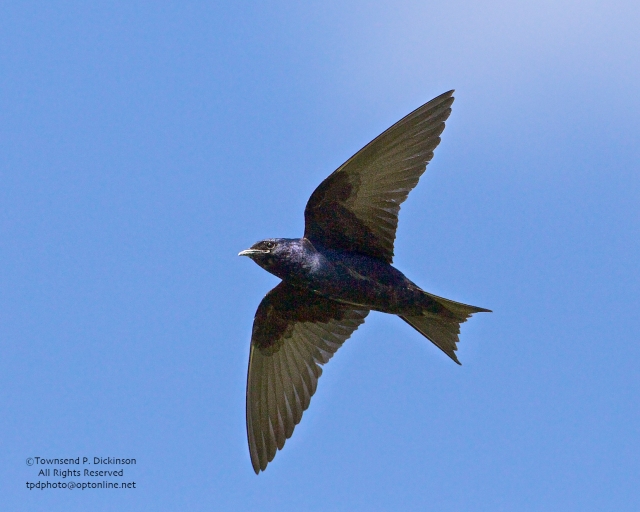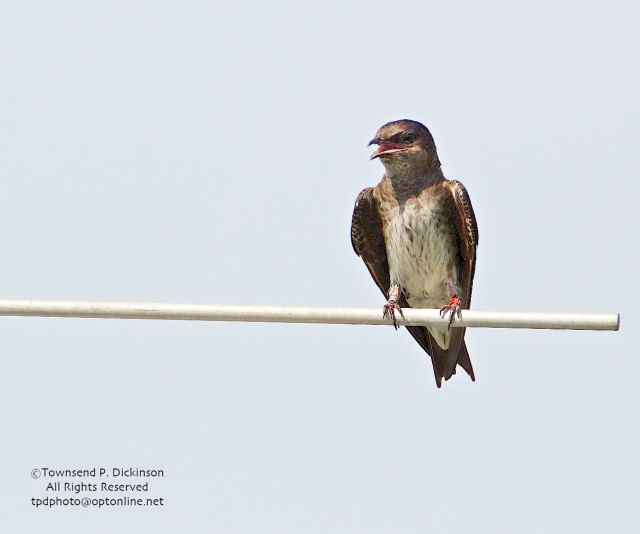The first thing you notice when you get a good look at a male Purple Martin is that they indeed are colorful. Purple Martins along with all the other aerial insectivores in Connecticut have been identified by the Connecticut Audubon Society in their annual State of the Birds 2013 report as species of special concern. The very air they fly in is the seventh habitat and the birds that depend on this habitat are all in a marked decline and no one knows why. I urge you to read the CAS Connecticut State of the Birds 2013 report to learn more about this subject.

Purple Martin, male, at nest site colony, spring, Connecticut Audubon Society Coastal Center, Milford Point, CT. ©Townsend P. Dickinson. All Rights Reserved.
The next thing you notice is that they live in little houses.

Purple Martins on nest box, Connecticut Audubon Society Coastal Center, Milford Point, CT. ©Townsend P. Dickinson. All Rights Reserved.
You may also notice that they are really good fliers.

Purple Martin, male in flight near colony, summer, Connecticut Audubon Society Coastal Center, Milford Point, CT. ©Townsend P. Dickinson. All Rights Reserved.
Flying allows them to move from their natal colony to a nearby one when they reach breeding age in the second year. By the way, they probably went to Brazil in the winter of the year they were born and then back again after each breeding season in North America.

Purple Martin, female, returning to her nest gourd has a red leg band that was banded as a nestling at Gazebo Phil’s Colony. summer, Connecticut Audubon Society Coastal Center, Milford Point, CT. ©Townsend P. Dickinson. All Rights Reserved.
The normal banding procedure is to place an aluminum band on the right leg, but special permits allow the placement of colored bands on the left leg. The theory is that each colony will be assigned a different color and that later one can learn about movements between natal colonies and nesting for those banded birds. Purple Martins in Connecticut are only banded as young birds. This adult female Purple Martin has a red band indicating that she was born in the Gazebo Phil colony the previous year.

Purple Martin, adult female (note aluminum band on right leg and red band on left leg indicates natal colony from Gazebo Phil in CT) on peach near nest gourds, summer, Connecticut Audubon Society Coastal Center, Milford Point, CT. ©Townsend P. Dickinson. All Rights Reserved.
Here are two juvenile Purple Martins perched in tree near their nest gourds hanging out sunning right and begging food from a passing adult left. You can see an aluminum band on the right bird.

Purple Martin, young of year l. begging, r. sunning, in tree near nest gourds, summer, Connecticut Audubon Society Coastal Center, Milford Point, CT. ©Townsend P. Dickinson. All Rights Reserved.
In another view of right juvenile Purple Martins perched in tree near their nest gourds you can see an aluminum band and a yellow band on the legs. Yellow indicates that this bird was banded at the Connecticut Audubon Society Coastal Center Colony.

Purple Martin, young of year (note yellow leg band indicates natal CAS colony in CT) begging from tree near nest gourds, summer, Connecticut Audubon Society Coastal Center, Milford Point, CT. ©Townsend P. Dickinson. All Rights Reserved.
This female Purple Martin returning to her nest gourd appears to have both red and yellow bands on her left leg. What do you make of it? Other States also have color banding programs for their Martins, I could not locate a database that listed all the possible color band combinations.

Purple Martin, female, returning to her nest gourd appears to have both red and yellow band. summer, Connecticut Audubon Society Coastal Center, Milford Point, CT. ©Townsend P. Dickinson. All Rights Reserved.
Purple Martins are aerial insectivores; they catch large flying insects from the air mass. Short of catching the birds in flight or examining the fecal pellets of the young, it is not easy to know exactly what they eat and feed their young. I noticed one day that I had captured a photo of a female Purple Martin returning to feed it’s young with a butterfly that was likely an Eastern Comma.

Purple Martin, female, brings butterfly (possibly Eastern Comma) back to nest for young, summer, Connecticut Audubon Society Coastal Center, Milford Point, CT. ©Townsend P. Dickinson. All Rights Reserved.
I went back the next summer and tried my luck at photography of flying martins again. This allowed me to determine a few of the insects being used to feed the young martins at the Milford Point Colony. Here is a female with a probable Hummingbird Clearwing Sphinx Moth, a day flying moth.

Purple Martin, female returns to nest to feed young with probable Hummingbird Clearwing Sphinx Moth, summer, Connecticut Audubon Society Coastal Center, Milford Point, CT. ©Townsend P. Dickinson. All Rights Reserved.
The literature on Purple Martins frequently mentions that they prey on dragonflies; here is a female with a probable Great Blue Skimmer Dragonfly.

Purple Martin, female returns to nest to feed young with possible Great Blue Skimmer Dragonfly, summer, Connecticut Audubon Society Coastal Center, Milford Point, CT. ©Townsend P. Dickinson. All Rights Reserved.
Here is a male Purple Martin in flight with an Annual Cicada that it is bringing back to it’s young. Note the eye is partially covered by the nictitating membrane for protection.

Purple Martin, male returns to nest to feed young with Annual Cicada, summer, Connecticut Audubon Society Coastal Center, Milford Point, CT. ©Townsend P. Dickinson. All Rights Reserved.
Here is the same male on a perch near it’s nest gourd with an Annual Cicada.

Purple Martin, male returns to nest to feed young with Annual Cicada, summer, Connecticut Audubon Society Coastal Center, Milford Point, CT. ©Townsend P. Dickinson. All Rights Reserved.
Most astounding was this female Purple Martin bringing a likely Morning Cloak Butterfly back to it’s nest. I don’t know how the martin could see where it was going as the butterfly prey seems to function as blinders.

Purple Martin, female brings butterfly (possibly Morning Cloak) back to feed young in nest gourd, summer, Connecticut Audubon Society Coastal Center, Milford Point, CT. ©Townsend P. Dickinson. All Rights Reserved.
When she flew by, I noticed that she could indeed see out to the side through the wings of the butterfly. It took her a few tries to land near her nest.

Purple Martin, female brings butterfly (possibly Morning Cloak) back to feed young in nest gourd, summer, Connecticut Audubon Society Coastal Center, Milford Point, CT. ©Townsend P. Dickinson. All Rights Reserved.
Colonial housing, now mostly man provided, and the right habitat are the keys to success for any Purple Martin Colony. You can enjoy these birds up close and personal with no fear of harm to the birds from the observation platform at the Connecticut Audubon Society Coastal Center at the Milford Point Sanctuary. I delight in the show put on by these birds, but I am very concerned about their decline which we know so little about.
Here is another article + BirdCallsRadio interview I did with Phil Donahue: Phil Donahue and Milan Bull talk Purple Martins!

Purple Martin colony nest gourds, summer, Connecticut Audubon Society Coastal Center, Milford Point, CT. ©Townsend P. Dickinson. All Rights Reserved.








The Iowa Purple Martin Organization gives you a big thumbs up. Thanks.
Sorry for being a late viewer of the martins. I am a purple Martin nut. I manage a county colony and two of my own. It took me 23 years to finally establish a colony on my property in Grafton, Ohio and more recently at Chautauqua Lake New York.. Your photos are fantastic! I love them. Thanks much. John Ryan
John it’s never to late to respond. Welcome to my blog site. Thank you for your compliment on the my husbands Townsend photos. He is a very talented photographer and helps to add to my articles often when it comes to birds. It certainly takes sometime to astablished colonies. Keep me posted as to how they do this year 2014. Cheers, Mardi
Congrats to you on this great article and to CT Audubon Society for its work with Purple Martins and the passionate landlords who are going the extra mile to help the species. I do some work in central Ohio and I also band the young. I am going to talk to my master bander to see if we can color band our birds. Best – Darlene Sillick, Powell Ohio
Great! .. and Towny’s images are stunning! .. beautiful!